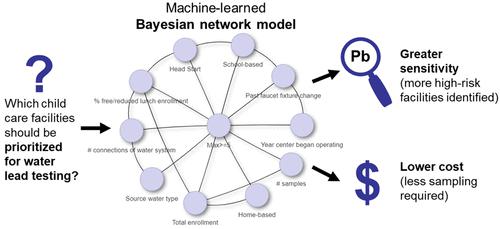当前位置:
X-MOL 学术
›
Environ. Sci. Technol.
›
论文详情
Our official English website, www.x-mol.net, welcomes your
feedback! (Note: you will need to create a separate account there.)
Improved Decision Making for Water Lead Testing in U.S. Child Care Facilities Using Machine-Learned Bayesian Networks
Environmental Science & Technology ( IF 10.8 ) Pub Date : 2023-03-18 , DOI: 10.1021/acs.est.2c07477 Riley E Mulhern 1 , A J Kondash 1 , Ed Norman 2 , Joseph Johnson 1 , Keith Levine 1 , Andrea McWilliams 1 , Melanie Napier 2 , Frank Weber 1 , Laurie Stella 1 , Erica Wood 1 , Crystal Lee Pow Jackson 1 , Sarah Colley 1 , Jamie Cajka 1 , Jacqueline MacDonald Gibson 3 , Jennifer Hoponick Redmon 1
Environmental Science & Technology ( IF 10.8 ) Pub Date : 2023-03-18 , DOI: 10.1021/acs.est.2c07477 Riley E Mulhern 1 , A J Kondash 1 , Ed Norman 2 , Joseph Johnson 1 , Keith Levine 1 , Andrea McWilliams 1 , Melanie Napier 2 , Frank Weber 1 , Laurie Stella 1 , Erica Wood 1 , Crystal Lee Pow Jackson 1 , Sarah Colley 1 , Jamie Cajka 1 , Jacqueline MacDonald Gibson 3 , Jennifer Hoponick Redmon 1
Affiliation

|
Tap water lead testing programs in the U.S. need improved methods for identifying high-risk facilities to optimize limited resources. In this study, machine-learned Bayesian network (BN) models were used to predict building-wide water lead risk in over 4,000 child care facilities in North Carolina according to maximum and 90th percentile lead levels from water lead concentrations at 22,943 taps. The performance of the BN models was compared to common alternative risk factors, or heuristics, used to inform water lead testing programs among child care facilities including building age, water source, and Head Start program status. The BN models identified a range of variables associated with building-wide water lead, with facilities that serve low-income families, rely on groundwater, and have more taps exhibiting greater risk. Models predicting the probability of a single tap exceeding each target concentration performed better than models predicting facilities with clustered high-risk taps. The BN models’ Fβ-scores outperformed each of the alternative heuristics by 118–213%. This represents up to a 60% increase in the number of high-risk facilities that could be identified and up to a 49% decrease in the number of samples that would need to be collected by using BN model-informed sampling compared to using simple heuristics. Overall, this study demonstrates the value of machine-learning approaches for identifying high water lead risk that could improve lead testing programs nationwide.
中文翻译:

使用机器学习贝叶斯网络改进美国儿童保育机构水铅测试的决策
美国的自来水铅测试项目需要改进方法来识别高风险设施,以优化有限的资源。在这项研究中,机器学习贝叶斯网络 (BN) 模型根据 22,943 个水龙头的水铅浓度的最大和第 90 个百分位数铅水平,预测北卡罗来纳州 4,000 多个儿童保育设施的整个建筑范围内的水铅风险。将 BN 模型的性能与常见的替代风险因素或启发法进行比较,用于告知儿童保育机构中的水铅测试计划,包括建筑年龄、水源和启蒙计划状态。 BN 模型确定了一系列与建筑物范围内的水含铅量相关的变量,以及为低收入家庭提供服务、依赖地下水的设施,以及拥有更多水龙头的风险更大。预测单个水龙头超过每个目标浓度的概率的模型比预测具有集群高风险水龙头的设施的模型表现得更好。 BN 模型的 F β分数比每个替代启发式方法高出 118-213%。与使用简单的启发式方法相比,这意味着使用 BN 模型知情采样可识别的高风险设施数量增加了 60%,需要收集的样本数量减少了 49% 。总体而言,这项研究证明了机器学习方法在识别高水铅风险方面的价值,可以改善全国范围内的铅检测计划。
更新日期:2023-03-18
中文翻译:

使用机器学习贝叶斯网络改进美国儿童保育机构水铅测试的决策
美国的自来水铅测试项目需要改进方法来识别高风险设施,以优化有限的资源。在这项研究中,机器学习贝叶斯网络 (BN) 模型根据 22,943 个水龙头的水铅浓度的最大和第 90 个百分位数铅水平,预测北卡罗来纳州 4,000 多个儿童保育设施的整个建筑范围内的水铅风险。将 BN 模型的性能与常见的替代风险因素或启发法进行比较,用于告知儿童保育机构中的水铅测试计划,包括建筑年龄、水源和启蒙计划状态。 BN 模型确定了一系列与建筑物范围内的水含铅量相关的变量,以及为低收入家庭提供服务、依赖地下水的设施,以及拥有更多水龙头的风险更大。预测单个水龙头超过每个目标浓度的概率的模型比预测具有集群高风险水龙头的设施的模型表现得更好。 BN 模型的 F β分数比每个替代启发式方法高出 118-213%。与使用简单的启发式方法相比,这意味着使用 BN 模型知情采样可识别的高风险设施数量增加了 60%,需要收集的样本数量减少了 49% 。总体而言,这项研究证明了机器学习方法在识别高水铅风险方面的价值,可以改善全国范围内的铅检测计划。











































 京公网安备 11010802027423号
京公网安备 11010802027423号